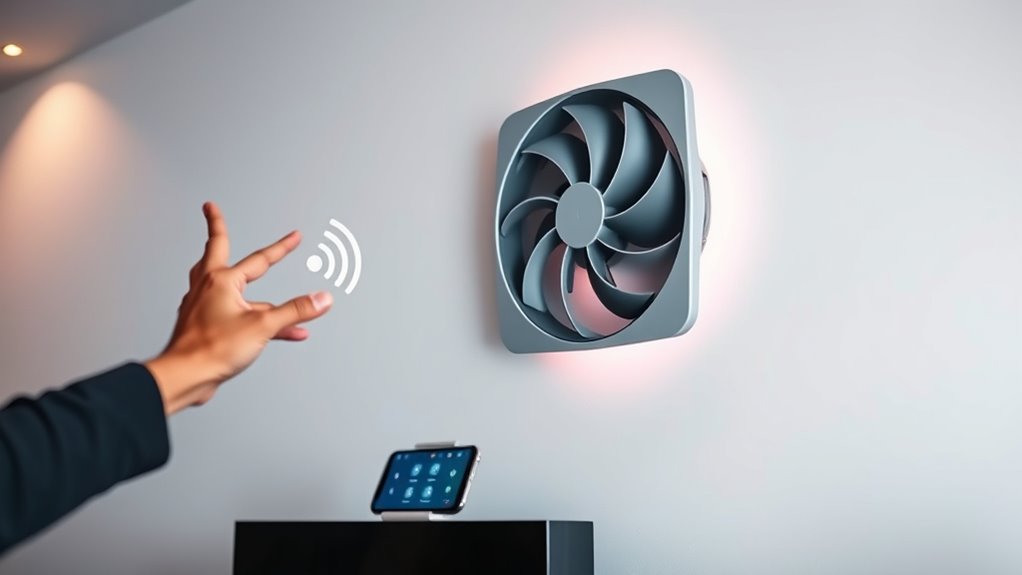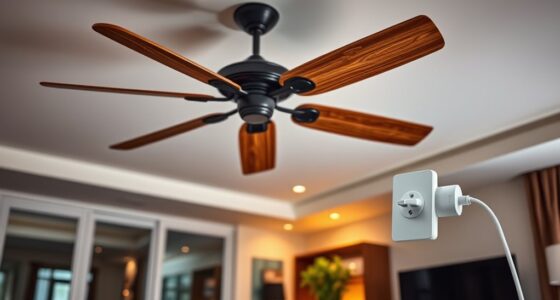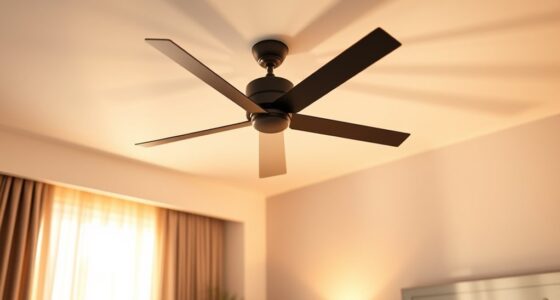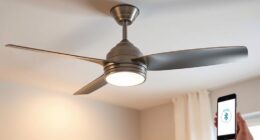Choosing between voice and app control for your smart fan depends on your priorities. Voice control offers hands-free, real-time operation and convenience, especially when your hands are busy or in emergencies. App control provides more precise adjustments, detailed customization, and reliable operation, making it ideal for environments with background noise. Both methods involve internet connectivity, but they differ in speed and security. To understand which suits your needs best, consider the technical strengths and limitations of each option.
Key Takeaways
- Voice control offers hands-free convenience and quick adjustments, ideal for immediate, on-the-go commands.
- App control provides more precise settings, scheduling, and detailed customization for long-term use.
- Voice commands depend on internet stability and may face accuracy issues in noisy environments.
- App-based control ensures reliable operation with lower latency and better security options.
- The best choice depends on whether you prioritize ease of use or detailed control features.
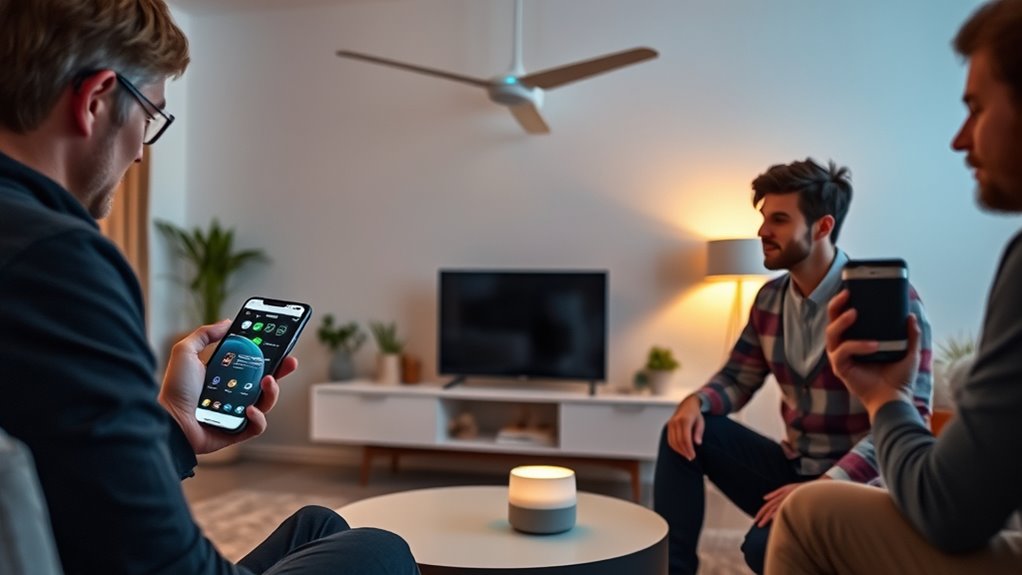
As smart home technology continues to evolve, choosing between voice control and app-based control becomes a crucial decision for users seeking efficiency and convenience. Both methods offer unique advantages and limitations, and understanding their technical distinctions can help you make an informed choice for managing your smart fan. Voice control relies on natural language processing and cloud-based recognition systems. When you speak commands, your voice data is transmitted to a cloud server where sophisticated algorithms interpret your intent. This process allows for real-time, hands-free operation, which is particularly beneficial when your hands are occupied or when quick adjustments are needed. However, voice recognition accuracy depends on the quality of your microphone, background noise levels, and the robustness of the system’s language models. Latency can occasionally be an issue, especially if your internet connection is weak or unstable, leading to delayed responses.
Voice control offers hands-free convenience but depends on internet stability and microphone quality.
In contrast, app-based control involves direct interaction through a dedicated mobile or web application. This approach typically offers a more precise and detailed interface, allowing you to adjust settings with a tap or click. Apps often provide additional functionalities such as scheduling, energy consumption monitoring, and customization options that are less accessible via voice commands. Because app controls operate locally or via a direct internet connection, they tend to have lower latency and fewer misunderstandings, especially in noisy environments. The downside is that app control requires manual engagement, which can be less convenient if you need to make quick adjustments while busy or away from your device.
From a technical perspective, voice control excels in providing seamless, natural interactions that mimic human conversation, but it’s more dependent on external factors like internet stability and microphone quality. App control, on the other hand, offers a more deterministic and data-rich environment, which can be essential for advanced configuration, detailed analytics, or integration with other smart home systems. Security considerations also differ; voice commands can be intercepted or misinterpreted, raising privacy concerns if not properly secured, while app-based controls typically involve encryption and authentication protocols that safeguard your data. Additionally, the contrast ratio of the system can influence how clearly commands are understood in various environments, emphasizing the importance of reliable technology.
Ultimately, the choice hinges on your specific needs for immediacy, precision, and integration. If you prioritize hands-free operation and quick, natural commands, voice control may be best. Conversely, if you require detailed customization and reliable operation regardless of environmental noise, app control offers a more stable and feature-rich experience. Both systems are continually advancing, and many smart fans now support hybrid control schemes, enabling you to leverage the strengths of each method for optimal convenience and efficiency.
Frequently Asked Questions
Can Both Voice and App Control Be Used Simultaneously?
Yes, you can typically use both voice and app control simultaneously on your smart fan. Most smart fans are designed for seamless integration, allowing you to switch between control methods or even use them together for added convenience. Your device’s firmware and app settings enable this functionality, ensuring you can command your fan via voice assistants or app interfaces without conflicts, enhancing user experience and flexibility in managing your smart fan.
Are There Compatibility Issues With Certain Smart Fan Brands?
Compatibility concerns can cause complications with certain smart fan brands. You’ll want to verify device compatibility with your chosen smart home platform—like Alexa, Google Assistant, or Apple HomeKit—before purchasing. Some brands may lack support for specific protocols or integration features, leading to limited control options. Always check manufacturer specifications and compatibility lists to guarantee seamless synchronization, avoiding frustrating functionality failures and ensuring your smart fan functions flawlessly within your smart ecosystem.
How Secure Are Voice Commands Compared to App Controls?
Voice commands typically pose higher security risks than app controls because they rely on voice recognition, which can be vulnerable to spoofing or interception. App controls usually require authentication, such as passwords or biometric verification, making them more secure. However, both methods depend on proper network security. To maximize safety, confirm your smart fan’s firmware is updated and use strong, unique passwords for app access and voice authentication.
Do Voice Controls Work During Internet Outages?
During internet outages, voice controls typically won’t work because they rely on cloud servers to process commands. If your smart fan uses local voice processing or a hub that doesn’t depend on internet, voice commands might still function. However, most standard voice-controlled systems require an active internet connection to verify and execute commands, making app controls more reliable during outages.
Which Control Method Offers Better Customization Options?
You’ll find app control offers greater customization options, allowing you to set specific schedules, fan speeds, and automation rules. For example, a case study shows users programming their fans to adjust automatically based on indoor temperature. Voice control typically provides simpler, limited commands, but app control’s detailed settings enable precise, personalized management, making it ideal if you prioritize tailored comfort and advanced features over quick voice commands.
Conclusion
Ultimately, choosing between voice and app control depends on your preferences and environment. Voice control offers hands-free convenience, ideal for quick adjustments, while app control provides detailed customization and scheduling options. Consider your daily routines and tech setup. As the saying goes, “A chain is only as strong as its weakest link.” By understanding the strengths and limitations of each method, you can optimize your smart fan for seamless, efficient use tailored to your needs.
